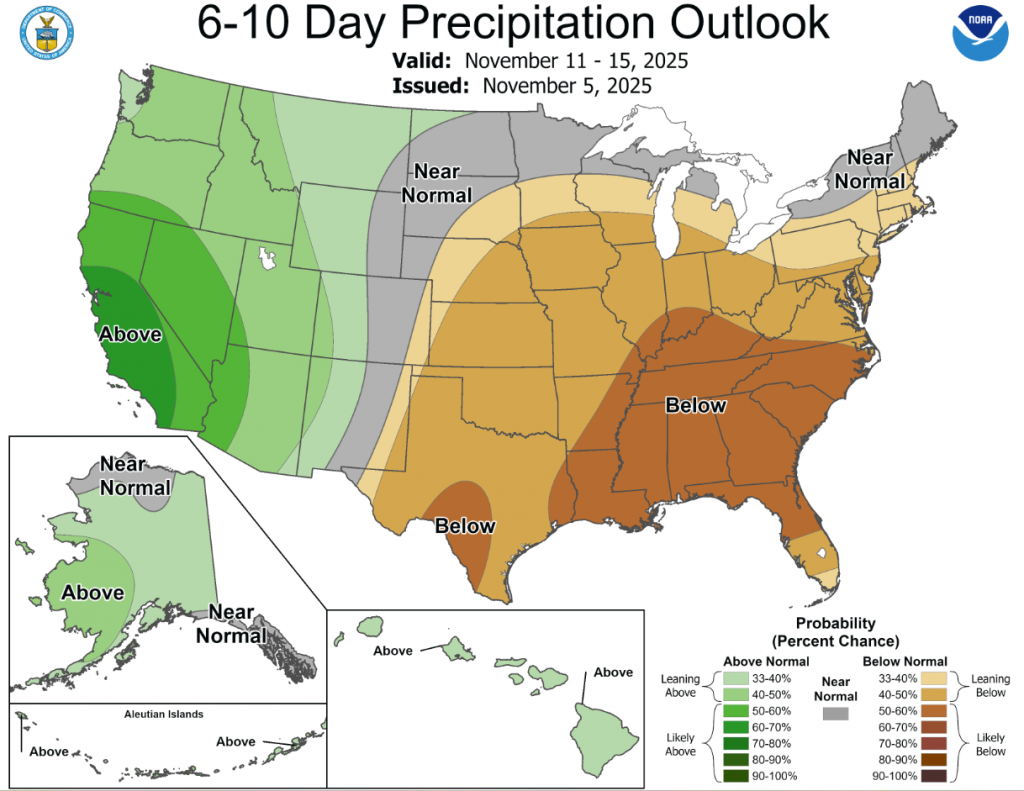
To view the latest Oklahoma drought map, CLICK HERE.
According to the latest Oklahoma Drought Monitor report, exceptional drought remains at 0 percent, unchanged from the start of the calendar year.
Severe Drought: Severe drought (D2) still remains in parts of central and southwestern Oklahoma, and new severe drought conditions have emerged in southern Oklahoma in Jefferson, Stephens, and Choctaw counties. All severe drought combined covers 6.23% of the state.
Widespread Dryness: Over 57 percent of the state is now experiencing abnormally dry to drought conditions versus over 52 percent last week.
According to the 6-to-10-day precipitation outlook map, Oklahoma is leaning below 40-50% chance of precipitation through November 15, and the very westernmost tip of the panhandle is leaning below 33-40% chance of precipitation through that same date.

To view the United States Drought Map, CLICK HERE.
Heavy precipitation again doused the Pacific Northwest, especially across the northern half of the Cascades and along the Washington and northern Oregon Coast. Between 6 and 10 inches of precipitation fell on most of northwesternmost Washington, and 6 to 8 inches fell on most of the northern Washington Cascades and a few areas near the Washington/Oregon border and along the northwestern Oregon Coast. From central Oregon northward, over 3 inches fell on the Cascades and coastal areas while 1.5 to 3.0 inches fell on other locations there from the Cascade Foothills to the Pacific Ocean. Farther east, locally heavy precipitation (1 to locally approaching 4 inches) was observed in northwestern Montana and northern Idaho. Other locations from the Great Plains westward to the Pacific Ocean were much drier, with most locations recording no measurable precipitation. Across the eastern half of the country, moderate to heavy precipitation (1 to locally 4 inches) fell on most of the Northeast, with the heaviest amounts falling on northern New York and in a swath from southwestern New England and the New York City area northward through northeastern New York and adjacent Vermont. Areas around the Outer Banks of North Carolina and southeastern Virginia also recorded heavy precipitation (2 to 4 inches) while amounts ranged from 1 to 3 inches in most of central and eastern Maine, New Jersey, central and eastern Pennsylvania, parts of the Mid-Atlantic region, and across Kentucky, most of Tennessee, and the adjacent Ohio and Mississippi Valleys. The west side of the Middle and Lower Mississippi Valley recorded generally 0.5 to locally 2.0 inches of precipitation, similar to totals reported across the upper Southeast, the central Carolinas, the central Appalachians, and the Upper Ohio Valley. In contrast, little or no precipitation was also observed across most of the Lower Mississippi Valley, near the central and eastern Gulf Coast, over the South Atlantic region from South Carolina through southern Florida, and through the Great Lakes region and adjacent portions of the Midwest.

In the southern plains, Moderate to heavy rain (1 to 3 inches) doused Tennessee, portions of Arkansas, and some adjacent areas last week. Dryness and drought over western Tennessee and much of Arkansas eased a bit as a result. Most other locations across Tennessee, Arkansas, eastern Oklahoma, and northern Mississippi reported several tenths of an inch of rain, and similar totals fell on isolated areas across southern Mississippi, Louisiana, and coastal Texas. The remainder of the Region, including most of Texas and Oklahoma, observed no measurable rain. After beneficial precipitation the prior week, the precipitation-free week allowed dryness and drought to re-intensify or expand over large parts of Texas and southern Oklahoma. After drought coverage (D1+) declined to about one-third of the state the prior week, coverage increased to over 45 percent this past week, which is the greatest extent since early May. Areas of late-season crop stress and some die-off has been reported across Oklahoma and Texas over the past few weeks.
In the High Plains, The High Plains Region is currently the Region least-affected by dryness and drought even though coverage in sum increased slightly this past week when most of the region reported a few tenths of an inch of precipitation at best. Measurable totals were restricted to eastern Kansas and southeastern Nebraska. The dry week induced a few areas of deterioration, but even so, less than 39 percent of the Region is experiencing some degree of dryness (D0+), and only 17.8 percent is enduring drought (D1+). Precipitation deficits on most time frames crept upward Region-wide, but areas of deterioration were relatively limited given the relatively low natural and human water demand this time of year.
In the Midwest, Moderate to locally heavy rain (1.5 to 3.0 inches) doused much of Kentucky and northeastern Ohio, but amounts were considerably lower at most locations. Amounts of an inch or a little more fell near the Ohio River and across central Ohio while a few tenths to a little more than an inch was observed over southern sections of Illinois and Indiana, in a swath from Missouri northward through interior Minnesota, and in the northern Great Lakes region. Little or no precipitation was observed over the remainder of the Great Lakes region, eastern Minnesota, central and northern sections of Indiana and Illinois, and northwestern Ohio. Predictably, this precipitation pattern resulted in continued improvement near the Ohio River and across most of Ohio while the dry week engendered persistence or intensification across the northern and central tier of the Region. In particular, increasing 60- and 90-day precipitation deficits prompted significant expansion of moderate drought (D1) across the south-central Upper Peninsula of Michigan, northern Wisconsin, and east-central Minnesota. As a result, even though coverage by some degree of dryness or drought (D0+) dropped from 68.8 to 65.1 percent last week, drought coverage (D1+) actually ticked up slightly from 33.4 to 34.8 percent.
To view the 6-10 Day Precipitation Outlook Map, click here.
To view the 6-10 Day Temperature Outlook Map, click here.
To view the Monthly Drought Outlook Map, click here.

















